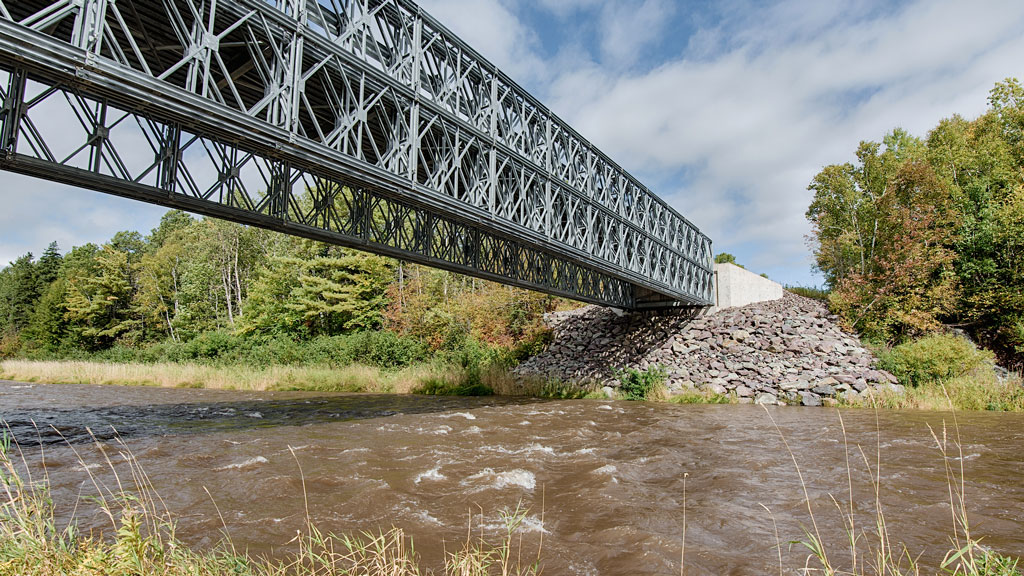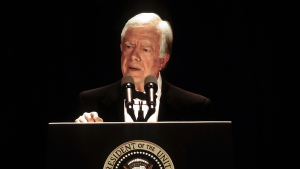Bridging over troubled waters is becoming a regular occurrence for companies who supply emergency and temporary structures and services as bridges, roads and culverts tumble, pushed by climate change.
“We are seeing more floods and flash floods,” said Steve Ross, president of Great Northern Bridgeworks (GNB), as he now pens in natural disasters when making his annual business plan.
GNB supplies permanent, portable and temporary bridges in B.C., Alberta, the Yukon and Northwest Territories.
Heavy spring rains layered over dense snow packs on mountainous areas in B.C. have led to larger amounts of water rushing down slopes.
“It comes down faster,” he said, as the volume and power knocks out roads, culverts and bridges.
“We are usually the second or third person called to the scene. Bad weather means more work for us.”
Ross said the situation is also aggravated by forest fires. B.C.’s severe forest fires of 2017 and 2018 saw vast tracts of forests destroyed. With no forest to absorb water, it sheets off the land carrying debris and soil clogging culverts and taking out roads years later.
In the 2018 Okanagan flooding, GNB provided services to protect access to Garnet Dam, including road construction, culvert removal and new low-profile bridging installation. In spring 2020, GNB supplied seven bridges to the Williams Lake area where flooding saw a state of emergency declared as a one-in-100-year flood took out the River Valley trail causing a major road collapse and compromising existing bridges.
The challenge GNB and other private sector emergency responders face is being prepared to provide the needed emergency support that clients, ranging from governments through to industry, need from a freshet season yet still maintain regular service.
“Right now, I have two bridges left,” Ross said. “And other companies are also in the same boat.”
Atlantic Industries Ltd.’s (AIL) B.C. and Yukon sales manager Matt Field also believes there are more weather-related events such as washouts, floods, culvert replacements and aftermaths of forest fires.
But how much is tough to quantify, he said, although it is a portion of business that exists and he prepares for it each winter.
AIL is part of the Atlantic Industries Group, which also owns Algonquin Bridge, a major supplier of emergency and temporary bridges. Algonquin’s panel modular bridges, Field said, can be stored in modules and then used when needed if local governments in remote areas want their own emergency bridges. The steel bridges, installed by contractors, range from two to 70 metres in spans.
B.C.’s northern Peace Region has seen increased severity of flooding become a reality.
“We have more frequency and more flooding,” said maintenance company Argo Road’s quality assurance manager Shelley Fulmes, located in B.C.’s southern Peace Region.
The region experienced another one-in-100-year flood in 2020.
“We have had two previously,” she said, pointing to floods in 2011 and 2016.
Fulmes’ flatter region doesn’t deal with the rapid-flow runoffs seen in the mountain areas but sheer volumes of water spilled over banks, carrying debris or washing out beaver dams contributing to clogged culverts. Pine Pass was hard hit in 2011 when rain-fuelled washouts occurred to the highway at 15 sites including bridges and again in 2016.
“When it rains, it rains a lot in a short time,” Fulmes said. The company has one of the highway ministry’s temporary bridges in its yard ready to respond and if more are needed, Fulmes said, she sources from the private sector.
Emergency incidents translate into more work.
She said: “When we can, we are now upgrading to a 200-year standard.”
Ross, Field and Fulmes are not off the mark.
Over a 10-year period ending in 2018, B.C. has had at least one large natural disaster per year, except for 2009, with a cost of $1.2 billion to government, according to the Emergency Management B.C. fiscal review. This year, the B.C. government has budgeted $514 million over three years to respond to and recover from extreme weather events.
Two reports warn that severe events are not stopping. The B.C. auditor general’s February 2018 report, Managing Climate Change Risks: An Independent Audit, and the Global Commission on Adaptation’s September 2019 report, Adapt Now: A Global Call for Leadership on Climate Resilience, emphasize that jurisdictions prepare for more frequent and severe floods and wildfires, as well as other hazards, due to the impacts of climate change.
Not everyone is convinced that climate change is the culprit behind severe incidents resulting in emergency call outs.
Scott Vyse, vice-president of marketing and sales for Northern Mat and Bridge, said: “There are many reasons besides weather.”
Severe forest fires seen in the past, he said, were the result of the mountain pine beetle killing trees and a loaded forest floor fuelling blazes.
Vyse isn’t seeing an increase in emergency callouts and he believes the reason is that many customers today are using “best practices” for bridges and mats that’s mitigating washouts.
While scientists argue the prolonged milder winters and droughts have facilitated beetle infestations, Vyse’s view reflects the difficulty of measuring how weather impacts infrastructure damage.
The World Resource Institute’s (WRI) updated Aqueduct Floods project sees a doubling of people worldwide affected by 2030 by rising waters. Increases are attributed to climate change, but also population growth, development in floodplains and sinking coastal lands. WRI predicts coastal flooding will affect 15 million people annually and cause US$177 billion in urban property damage, while river flooding is expected to affect 132 million people each year and cause US$535 billion of property damage in urban areas.
B.C. does not keep cost figures on how weather-related incidents are impacting its infrastructure, both in terms of an emergency response capacity and longer term capital cost replacement. Such figures are spread across a number of ministries and agencies such as Forests, Lands, Natural Resource Operations and Rural Development; Transportation and Infrastructure; Emergency Management BC; Agriculture; and Municipal Affairs and Housing.
The impact cost can also be drawn out over years. In February 2020, the BC government announced it would be staring construction on a permanent bridge in the Cherry Creek area after a washout in 2018 led to the installation of a temporary bridge. In April 2018, high-water levels caused Narcosli Creek to erode over five sections of the West Fraser Road (17 kilometres south of Quesnel) and a new road design has been completed this year with $103 million earmarked for a new access route to be completed by 2023.
Grand Forks is a city that has been repeatedly hard-hit by flooding but also reflects the challenge municipalities undertake to amend their infrastructure and plan for future flooding threats.
The city has obtained $50 million from Infrastructure Canada, which administers the Disaster Mitigation and Adaption Fund and the B.C. government has committed to pay for new diking, drainage systems, restoration of a floodplain to wetlands and buy-out of homeowners in the floodplain badly affected by the 2018 flood. Currently, 80 buyouts have been facilitated.
Graham Watt, spearheading the city recovery initiative, said the focus is on providing infrastructure that protects residential and commercial areas while opening up areas where flood waters can go without causing damage.
The 2018 flood demonstrated the challenges in planning a response. It was a one-in-200-year flood, but its flow was 18 per cent higher than earlier 1990s hydrology calculations for a 200-year flood, Watt said.
Grand Forks Mayor Brian Taylor said the city is attempting to find the best solution moving forward. “There is a feeling that climate change is almost unpredictable,” he said, pointing to a once safe standard for a one-in-200-year flood. “Now, that has gone out the window.”











Recent Comments
comments for this post are closed